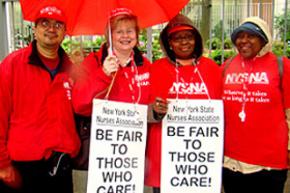Strike threat wins new contracts for nurses
New York State Nurses Association member reports on contracts at four big hospitals--and the role the Occupy movement played in building solidarity.
SOME 10,000 nurses at four of the largest New York City hospitals recently settled contracts that include modest raises and increased staffing. The deals also include lump-sum payments that partially offset a recent arbitration decision requiring private-sector nurses represented by the New York State Nurses Association (NYSNA) to contribute to their health care fund for the first time.
After near simultaneous strike authorization votes at St. Luke's/Roosevelt Medical Center, Montefiore Medical Center, New York Presbyterian's Columbia University Medical Center, and Mount Sinai Medical Center--including actual strike notices at Montefiore and St. Luke's/Roosevelt--management moved to meet most of the nurses' demands.
When asked why she thought the employer had such a rapid change of heart, Judy Sheridan-Gonzalez, the local bargaining unit president at Montefiore and vice president of NYSNA, said, "Strike vote, strike vote, and strike vote."
The League of Voluntary Hospitals, a grouping of New York City hospital employers, was brimming with confidence this summer after the arbitrator's ruling employee contributions to health care. The arbitrator explicitly stated that normal rules of pattern bargaining do not apply in this economic climate and the hospitals a mandate to impose the health care contributions.

"The main goal of the employer was to use the economy to persuade us that they had to make deep cuts to our benefits in order to remain competitive and financially solvent, even though the CEO of MMC [Montefiore Medical Center] has received a whopping $4 million dollars in compensation in 2010 and that financial statements revealed that MMC was healthy and robust financially," said Karine Raymond, a nurse at Montefiore.
Two events this fall changed management's attitude--the election of a new, more aggressive, rank-and-file leadership to the board of directors of the New York State Nurses Association, and the emergence of the Occupy Wall Street movement.
Rank-and-file members at the "Big Four" hospitals had been meeting on their own since earlier in the year and planning for joint action. But the newly elected union leadership, fulfilling a campaign promise, turned these contract battles into an organization-wide priority.
Several members of the reform caucus are rank-and-file leaders at the Big Four hospitals, including three members of the board of directors and the president and treasurer of the Delegate Assembly, the most powerful union body outside of the board.
It's also safe to suppose that some of the city's largest and most profitable hospitals didn't want to find out what having four hospitals on strike at the same time would look like in the era of Occupy Wall Street.
The League may have had a suspicion that a high-profile action by members of the most trusted profession in the U.S. may have galvanized the mass sentiment in support of the Occupy movement, which has been attempting to reorient to a new phase of the movement following the police raids on encampments at the end of last year.
"The fear of a citywide strike involving 10,000 unified RNs, coupled with community support and the cost to the facility of a strike, was a definite catalyst for management to settle their respective contracts," said Raymond.
Occupy Wall Street working groups, including the Labor Outreach Committee, Take Back the Bronx and others, had already pledged support and were preparing to mobilize.
EVEN THOUGH these contract settlements are a much-needed boost for the labor movement in the face of the employers' all-out assault on so many fronts, they weren't outright victories either.
There are still unresolved questions related to the health care fund at Columbia, for instance. Also, a campaign to reverse the arbitrator's ruling entirely--and not just accept extra payments that partially offset cost of contributions--is desperately needed since this sets a terrible precedent for all private-sector workers.
Finally, there are still close to 10,000 nurses who continue to work without a contract, mostly concentrated in the New York City and Westchester County public-sector hospitals.
In this battle, the union faces a much more intransigent employer: Mayor Michael Bloomberg, armed with the Taylor Law, which prohibits striking by public-sector workers. Bloomberg and city officials clearly feel the needs of hospital patients and nurses can wait, forever if necessary.
A rejuvenated organizing effort around the contract, including a campaign around safe staffing levels, could help pressure the city to settle. This could be part of a broader campaign involving public- and private-sector workers across New York City to build support for not only health care workers, but transit workers and Verizon workers as well. Building such solidarity will be critical for maintaining the integrity of public services and drawing the line against the continual demand for concessions from employers in both the government and private industry.
As this article was being written, the union delivered a strike notice at Flushing Hospital, where over 400 RNs have had their pensions cut off. The strike is set to take place on February 7.
This is the next major battle in the struggle for the rights of both nurses and patients in New York City.


